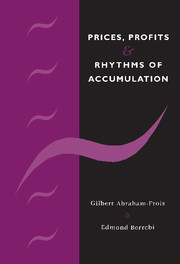Book contents
- Frontmatter
- Contents
- Preface
- 1 The golden rule of accumulation and prices
- 2 Systems of production prices
- 3 Irregular and decomposable systems
- 4 The analysis of joint production
- 5 Standards and blocking goods
- 6 Labour values and the problem of transformation
- 7 Switch in methods of production
- 8 The dynamic evolution
- Notes
- References
- Index
3 - Irregular and decomposable systems
Published online by Cambridge University Press: 06 July 2010
- Frontmatter
- Contents
- Preface
- 1 The golden rule of accumulation and prices
- 2 Systems of production prices
- 3 Irregular and decomposable systems
- 4 The analysis of joint production
- 5 Standards and blocking goods
- 6 Labour values and the problem of transformation
- 7 Switch in methods of production
- 8 The dynamic evolution
- Notes
- References
- Index
Summary
The purpose of the present chapter is to analyse peculiar technology configurations and their effects on systems of production prices and systems of activity levels. Some of them only concern the technology matrices, or more precisely, system [A, I]. This is a problem of decomposability and indecomposability. Some other peculiarities can be underlined if we integrate into the analysis the structure of the needs of labour for the various activities or the structure of the final consumption; hence the distinction between regular and irregular systems which brings to light two types of irregularities.
Decomposable systems
In order to distinguish between two types of goods, basics and non-basics, it is desirable to specify the properties of decomposable and indecomposable matrices. Indeed, under the assumption of decomposability, the production prices of all goods are not determined simultaneously. However, since the basic sector plays a dominant role that we shall specify, the maximum rate of profit is not necessarily determined by the production conditions of basic commodities; a detailed analysis of Sraffa's famous ‘beans’ example will help us emphasise this. More generally, we will show the importance of a classification of basic goods of different degrees in a k-sector model; the maximum rate of profit R is determined by a set of goods, basics or not, that we shall call ‘blocking goods’.
- Type
- Chapter
- Information
- Prices, Profits and Rhythms of Accumulation , pp. 59 - 99Publisher: Cambridge University PressPrint publication year: 1997



